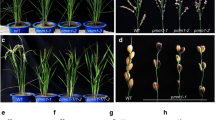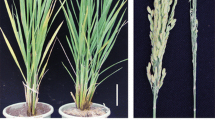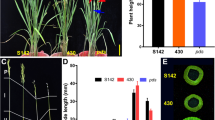Abstract
Rice (Oryza sativa L.) inflorescence (panicle) architecture is an important agronomic trait, serving as one of the determinants of rice yield. A number of genes related to panicle development have been cloned and functionally characterized so far. However, more information is needed for fully understanding of the mechanism underlying the panicle development. In the present study, we identified a clustered spikelets 4 (cl4) mutant in the 93-11 genetic background. Compared to its wild-type 93-11, cl4 mutant has a typical clustered spikelets phenotype with all primary branches clustered on the base of the main rachis and 2–3 abnormal spikelets clustered on the primary branches. Moreover, cl4 mutant also shows shorter plant height than that of the wild type. Map-based cloning strategy is performed to clone the CL4 gene. As a result, CL4 is demonstrated to encode a putative cytochrome P450 protein CYP724B1, which is involved in brassinosteroid biosynthesis. To confirm our mapping result, the CL4 RNAi transgenic plants are generated. And the transgenic plants also show similar phenotype as the cl4 mutant. These results provide strong evidence that CL4 plays an important role in rice panicle development as well as plant height regulation.





Similar content being viewed by others
References
Ikeda K, Nagasawa N, Nagato Y (2005) ABERRANT PANICLE ORGANIZATION 1 temporally regulates meristem identity in rice. Dev Biol 282:349–360
Ikeda K, Ito M, Nagasawa N et al (2007) Rice ABERRANT PANICLE ORGANIZATION 1, encoding an F-box protein, regulates meristem fate. Plant J 51:1030–1040
Li XY, Qian Q, Fu ZM et al (2003) Control of tillering in rice. Nature 422:618–621
Chuck G, Muszynski M, Kellogg E et al (2002) The control of spikelet meristem identity by the branched silkless1 gene in maize. Science 298:1238–1241
Komatsu M, Maekawa M, Shimamoto K et al (2001) The LAX1 and FRIZZY PANICLE 2 genes determine the inflorescence architecture of rice by controlling rachis-branch and spikelet development. Dev Biol 231:364–373
Komatsu M, Chujo A, Nagato Y et al (2003) FRIZZY PANICLE is required to prevent the formation of axillary meristems and to establish floral meristem identity in rice spikelets. Development 130:3841–3850
Komatsu K, Maekawa M, Ujiie S et al (2003) LAX and SPA: major regulators of shoot branching in rice. Proc Natl Acad Sci USA 100:11765–11770
Samach A, Klenz JE, Kohalmi SE et al (1999) The UNUSUAL FLORAL ORGANS gene of Arabidopsis thaliana is an F-box protein required for normal patterning and growth in the floral meristem. Plant J 20:433–445
Kurakawa T, Ueda N, Maekawa M et al (2007) Direct control of shoot meristem activity by a cytokinin-activating enzyme. Nature 445:652–655
Ashikari M, Sakakibara H, Lin SY et al (2005) Cytokinin oxidase regulates rice grain production. Science 309:741–745
Li SB, Qian Q, Fu ZM et al (2009) Short panicle1 encodes a putative PTR family transporter and determines rice panicle size. Plant J 58:592–605
Huang XZ, Qian Q, Liu ZB et al (2009) Natural variation at the DEP1 locus enhances grain yield in rice. Nat Genet 41:494–497
Zhou Y, Zhu JY, Li ZY et al (2009) Deletion in a quantitative trait gene qPE9-1 associated with panicle erectness improves plant architecture during rice domestication. Genetics 183:315–324
Suzaki T, Sato M, Ashikari M et al (2004) The gene FLORAL ORGAN NUMBER1 regulates floral meristem size in rice and encodes a leucine-rich repeat receptor kinase orthologous to Arabidopsis CLAVATA1. Development 131:5649–5657
Chu HW, Qian Q, Liang WQ et al (2006) The floral organ number4 gene encoding a putative ortholog of Arabidopsis CLAVATA3 regulates apical meristem size in rice. Plant Physiol 142:1039–1052
Suzaki T, Toriba T, Fujimoto M et al (2006) Conservation and diversification of meristem maintenance mechanism in Oryza sativa: function of the FLORAL ORGAN NUMBER2 gene. Plant Cell Physiol 47:1591–1602
Nakagawa M, Shimamoto K, Kyozuka J (2002) Overexpression of RCN1 and RCN2, rice TERMINAL FLOWER 1/CENTRORADIALIS homologs, confers delay of phase transition and altered panicle morphology in rice. Plant J 29:743–750
Zhang SH, Hu WJ, Wang LP et al (2005) TFL1/CEN-like genes control intercalary meristem activity and phase transition in rice. Plant Sci 168:1393–1408
Jodon NE (1957) Inheritance of some of the more striking characters in rice. J Hered 48:181–1921
Nagao S, Takahashi M (1963) Genetical studies on rice plant. XXVII. Trial construction of twelve linkage groups of Japanese rice. J Fac Agric Hokkaido Univ 53:72–130
Chen HQ, Liu G, Zhu XD et al (2002) Observation and genetically analysis on character of clustered spikelets in rice. J Nanjing Agric Univ 25:116–118
Zheng LY, Zhu XD, Qian Q et al (2003) Morphology and mapping analysis of rice (Oryza sativa L.) clustered spikelets (Cl) mutant. Chin Sci Bull 48:559–562
Tian C, Zhang T, Jiang KF et al (2010) Genetic analysis and preliminary gene mapping of rice clustered spikelets mutant. Mol Plant Breed 8:29–34
Zhou P, Deng QM, Tu SH et al (2012) Genetic analysis and gene mapping of the clustered spikelets mutant (Cl-dz) of rice. Fujian J Agric Sci 27:481–484
Zhang Y, Li YF, Xie R et al (2006) Development of NILs with Cl-gene of rice restorer and evaluation on the near-isogenic level. Acta Agron Sin 32:397–401
Yan CJ, Zhou JH, Yan S et al (2007) Identification and characterization of a major QTL responsible for erect panicle trait in japonica rice (Oryza sativa L.). Theor Appl Genet 115:1093–1100
Rogers SO, Bendch AJ (1988) Extraction of DNA from plant tissues. In: Gelvin SB, Schilperoort RA (eds) Plant molecular biology manual, vol 6. Kluwer, Dordrecht, pp 1–10
Tanabe S, Ashikari M, Fujioka S et al (2005) A novel cytochrome P450 is implicated in brassinosteroid biosynthesis via the characterization of a rice dwarf mutant, dwarf11, with reduced seed length. Plant Cell 17:776–790
Acknowledgments
This work was supported by the National Natural Science Foundation of China (31171158), the Ministry of Science and Technology (2011ZX08009-003-005), the Natural Science Foundation of Jiangsu Province (BK2012684), the project of Six Talent Peaks in Jiangsu Province and the Priority Academic Program Development of Jiangsu Higher Education Institutions.
Conflict of interest
The authors declare that they have no conflict of interest.
Author information
Authors and Affiliations
Corresponding author
Additional information
Min Guo and Yi-Hao Yang contributed equally to this work.
About this article
Cite this article
Guo, M., Yang, YH., Liu, M. et al. Clustered spikelets 4, encoding a putative cytochrome P450 protein CYP724B1, is essential for rice panicle development. Chin. Sci. Bull. 59, 4050–4059 (2014). https://doi.org/10.1007/s11434-014-0568-z
Received:
Accepted:
Published:
Issue Date:
DOI: https://doi.org/10.1007/s11434-014-0568-z




